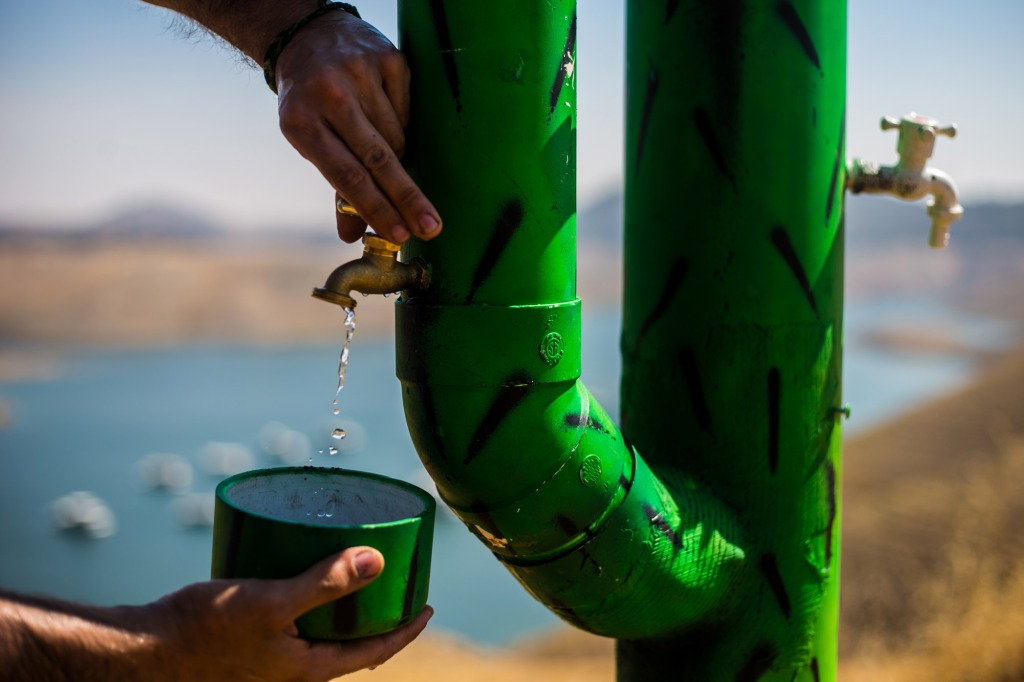“The arts matter because we matter, and our stories matter. We are moving miracles, walking creators engaging in a cosmic dance. The art we express is timeless.”
–Mohammed Sheriff, Division Coordinator at the National Endowment for the Arts (USA)
By Oliver Kammeyer
At The Optimist Daily, we keep our eyes peeled for creative solutions to problems we all face. Sometimes, a new take is exactly what’s needed. This week we looked at the ways in which artists reframed important environmental issues and piqued viewers interest and emotions through artistic expression. This week we invite you to dive in with us into the power of art.
Art helps us understand ourselves, each other, and the environment in which we live, broaching the psychological and communal and introducing us to the unknown. It’s the mutual friend of all of humanity. Artists throughout history have creatively used visual, written, or musical expression to bring viewers to the issues society faces and invite them to be part of the solution.
In 1975, Bob Dylan wrote Hurricane on the unjust conviction of Black boxer Rubin “Hurricane” Carter. In 1808. Francisco Goya’s lithographs depicted the war atrocities committed by French soldiers in Spain. Anton Chekov pioneered short fiction by writing about the difficulties faced by the aristocracy and the serfs alike.
These creative souls made their viewers empathize with their subjects, like all true art does, showing that we all have more similarities than differences.
Today, climate change is something that we all have in common. The National Ocean Service (NOAA) confirmed last week that sea levels will rise a whole foot by 2050, and in the same week, the journal Nature: Climate Change published a report on the megadrought in the Southwest, finding it is worse than it’s been in 1200 years. Artists have begun to create to bring a more visceral awareness to those of us who have been unable or unwilling to “see” this inevitability. Adam McKay’s 2021 film “Don’t Look Up”, for example, taps into dark humor to help us understand what is at stake with a changing climate, but his is just the newest voice in the arts imploring us to pay attention to the changes all around.
“Art is a wound turned into light.” – Georges Braque, French painter
The Optimist Daily’s publishing partner, the World Business Academy is proud to be part of an amazing group of “Climate Change Trailblazers” who have received funding from an organization called Invoking the Pause. A fellow grantee has created “a ‘world-wide water series’ over the past 8 years connecting local communities around the world with water, deep time, and the impacts of sea level rise.”
Sarah Cameron Sunde uses the rising tide as a metaphor in her performance art/video piece, 36.5 / A Durational Performance with the Sea (2013-present). She has traveled to seven locations around the world threatened by sea-level rise and stood in a tidal area for 12-13 hours, letting the water rise up around her and fall again. Sunde explains her work this way:
“The tide tracks time on my body viscerally, and functions as a metaphor for the changing environment. The water is my collaborator, and the risks are real. I stay present in the sensations, attempt to embody the ocean and find a way to endure the struggle. The public is invited to stand in the water with me for however long they like and to participate in performing a series of physical gestures from the shore, creating a human clock that communicates to me each hour that passes.”


Sunde has recorded herself and others in Bass Harbor, Maine; Akumal Bay, Mexico; San Francisco Bay, California; the North Sea in the Netherlands; the Bay of Bengal, Bangladesh; the Bay of All Saints, Brazil; and Bodo Inlet, Kenya. She will go on next to Te Manukanukatanga ō Hoturoa, Aotearoa-New Zealand, and then to her final stand in the New York Estuary in September 2022 (see the bottom of this article for ways you can participate in this final presentation of Sunde’s work).
You can’t help picturing yourself, your community, as you watch Sunde, and the locals that accompany her, sink into the tide, with the water touching their chins. Another foot would completely submerge Sunde, and her participants, in all of the six of the continents she records in. The water’s rise is so gradual, its movement is invisible. It is quiet and entirely surrounds her.
Perhaps this is the reason why so many fail to notice the change on our planet? Humans adapted to react to immediate crises: a fire breaks out, another country attacks, a storm bursts out of the sky. When it comes to the increasing temperature and the tide, though, calamity comes in a crawl not a leap.
We need to trust the eyes of our experts when change is imperceptible to the average viewer. It’s like listening to the advice of a doctor when they tell you your cholesterol is off the charts. If you keep doing what you’re doing, you’ll probably get a heart attack. You can’t see the cholesterol they’re talking about. You might do nothing, or you might listen to what your doctor tells you and change your diet.
Artists show, they don’t tell.
Another artist showed us a different part of the same story in California, emblematic of the Southwest where the droughts faced today are the worst they’ve been in 1,200 years. Mundano is a Brazilian street artist who called attention to the drought in his hometown São Paulo before taking his installation on the road to the US in 2015.
Mundano fashions cacti out of recycled water pipes. He placed these in eight California lakes and reservoirs that supply water to cities and farmland. At Lake Mclure in Mariposa, California one of his famous cacti stands over a greatly diminished waterline at eight percent normal capacity of the lake.

“I started painting cacti as graffiti a long time ago,” he says. “To me, they are the symbol of strength and the best representation of the Brazilian people, who survive on very little — but it is also an international symbol anyone can identify with.”
These cacti are functional taps, the viewer can turn a faucet and receive a tiny trickle of water (never very much, just so as not to wastewater). Along with dried lakes and reservoirs, Mundano has placed his cacti near fracking sites, where a great deal of water is used to extract natural gas, and even in a now-defunct water park.
A cactus is actually a natural source of water in, sometimes, the most arid environments on earth. Where most other flora would die, these plants survive. People can even tap a cactus and get water out of it in dire straits. This is the impression viewers get visiting one of Mundano’s installations and turning on the faucet: one of a potential future.
This is the profound labor that art has to deal with, emotionally communicating to us where we might be in the years to come with climate change. Some might think “this will happen to someone, but not to me.” But you look at Mundano paddling a rusty boat in the dry dirt of what used to be the bottom of Laguna Lake, California, and you have to think that the former owner of that boat must’ve thought the same thing.
In 2021, Mundano used ashes from the massive fires in the Amazon to paint a 1000 square meter mural on the side of a building in São Paulo, using his creative force to comment on environmental catastrophe in new ways.
“The arts matter because they are the record of our civilization and the arrow pointing forward to our future.”
– Greg Reiner, Director of Theater and Musical Theater, NEA
History is so often the record of politics, but art is the record of the people. Art informs us and tells our story at the same time. While these pieces have told cautionary tales about what awaits us with climate change, the story has not been finished on how we’ll adapt and persevere. Researchers, entrepreneurs and whole communities are continuing to make advances in wind energy technology, preserving ecosystems, and engaging people in climate action.
There’s nothing wrong with us that can’t be fixed by what’s right with us.
______________________
Oliver Kammeyer joined the team at The Optimist Daily in February, 2022. He holds a Masters in Fine Arts from Emerson College. He loves the arts and normally writes fiction, but he now prefers to write about our environment and sustainable global development. He lives in Tucson, Arizona.
More about 36.5 / A Durational Performance with the Sea












